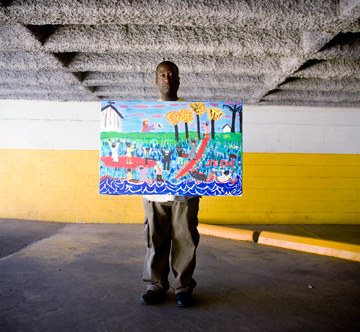For 15 years, the Stewpot Art Program has been a refuge for homeless men and women. On the second floor of The Stewpot, across the street from First Presbyterian Church, walls that lead to the classroom are covered with paintings and drawings, floor to ceiling, a range of styles and expertise as diverse as the experiences of their makers. Eight classes are given each week. As many as 30 students come regularly. Shows are mounted and work is sold, with all but 10 percent of proceeds going straight to the artist. The Stewpot is a 33-year-old day shelter and resource center for homeless and at-risk adults and children.
“Some want to be professionals. Some just want to experiment,” says Brannum, who has a degree in painting and drawing from SMU and has directed the art program for four years. “What I love the best is when they come in, there are concerns weighing on their minds. Then, they start opening up, they start working, they get interested in their work, and those things start to be important to them. They start to think, ‘How can I make this piece better?’ And they begin expanding in this wonderful way. Sometimes, I have to push them out the door when it’s time to leave.”
===“What he is doing is so naturalfor him, and done with such joy and spontaneity, that I can’t imagine he could beat that with all those other techniques. Basically, we let the guy do his thing.”!==
At first, Brackens drew with pastels, creating portraits of famous people in rich, saturated colors. He had never painted, but with Brannum’s encouragement, he tried. He dreamed up a house by a lake, with a multicolored roof. “It was just awful,” he says, “but someone bought it.” His second piece sold for $50. He has since painted hundreds of canvases, taking two to three days to complete each one. His parents have his work hanging in their homes. And Laura Bush did, too, displaying a religious rendering she received as a gift in the residential part of the White House.
“I think it was a guest room,” Brackens says. “She sent me a letter.”
Last year, he earned $10,000 solely from his art.
Brackens quickly found his style as a folk artist, using blazing colors and simple shapes to tell tales of family, friends, struggle, faith. While he waits for the studio to open, he reads art books off the shelves at the public library. “As trained artists,” Brannum says, “we have to bite our tongue sometimes, wanting to teach him about structure and things like perspective. But what he is doing is so natural for him, and done with such joy and spontaneity, that I can’t imagine he could beat that with all those other techniques. Basically, we let the guy do his thing.”
A bench appears under the two ladies, one in a lilac dress and shoes, the other in pink, with white polka dots. Brackens paints from his head and has little interest in reproducing reality, which, he says, would turn out nothing like it truly is, anyway.
This commitment, the way he spends most of his days—getting up at 4:30 in the morning to make the early bus into town, leaving at noon for lunch at the shelter, returning to work more—the life he has structured around his new gift does not feel, to Brackens, like a choice. “I always think about how far I’ve come from the streets. But from them, I got this opportunity to try. It is unlikely. But this is the thing in life I’ve been searching for,” he says. “I think it’s what I’m supposed to do.”
He drags his brush upward, slowly, from the shoulders of one of the women, sending her arms overhead. They have halos of gray hair and circles for mouths. No eyes, no noses. One is telling the other something funny. They are having a good time on the bench.
The piece is called Will We Be Friends For Life? Brackens thought of the question first, before deciding on the composition. The answer, he firmly believes, is yes. “If I am trying to portray a message, I want to show the good part of it. If I can make something positive in a painting, I know it will turn out that way in life because it turned out that way in the painting. I guess I’m trying to encourage myself, to believe that I can live like the stories I sometimes tell.”






